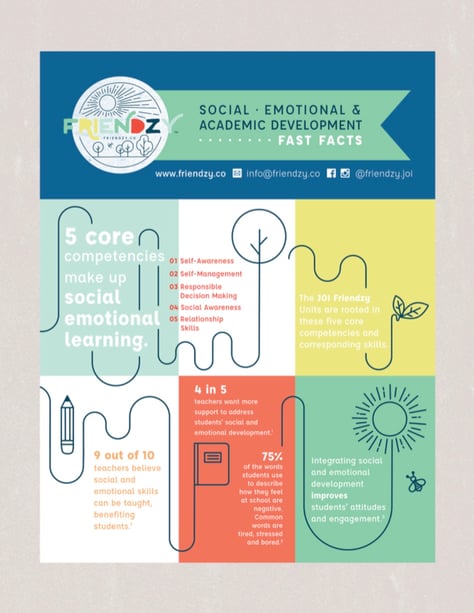Let’s talk about feelings. 😓
As an early childhood teacher, you play a critical role in the development of your students’ emotional intelligence.
Emotional intelligence is the ability to understand and manage one’s own emotions, as well as to recognize and respond appropriately to the emotions of others.
Developing emotional intelligence in children can help them:
- navigate social situations
- manage stress
- build healthy relationships throughout their lives.
Today, we’ll explore some proven strategies that teachers can use to support emotional intelligence in their students. 👶👐
Why feelings matter in early childhood education.
The average person has more than 400 emotional experiences every day.
Feelings are an integral part of the human experience. They provide us with information about the world and our place in it. For young children, feelings play an essential role in their development and learning. Emotional intelligence, or the ability to recognize, understand, and manage one’s emotions, is a crucial skill for success in life.
As early childhood teachers, it’s your responsibility to foster and nurture emotional intelligence in young children to help them become outstanding people.
Download your FREE TEMPLATE to easily build your emotion-based lessons. Happy teaching! 👩🏫
Primary Vs. Secondary Emotions
Primary emotions are universal, which means they’re experienced by all humans across cultures and ages. There are six primary emotions:
- Anger
- Fear
- Surprise
- Disgust
On the other hand, secondary emotions are more complex. They’re often a combination of two or more primary emotions. These emotions arise as a result of the interpretation or evaluation of a situation, experience, or event. Some of the secondary emotions are:
- Guilt
- Shame
- Envy
- Jealousy
- Pride
- Hopelessness
- Despair
- Regret
- Disappointment
- Frustration
Both primary and secondary emotions are important and play a crucial role in our overall emotional well-being, especially for children.
Expert tips: How to support emotional intelligence for your students.
Young children experience a wide range of emotions, from joy and excitement to fear and frustration.
These emotions can be intense and overwhelming for them, especially when they lack the language and skills to express themselves effectively. However, feelings serve a purpose. They communicate to us and others what is going on inside of us and help us navigate social situations.
When young children experience negative emotions, such as anger or sadness, it is easy to dismiss or minimize their feelings. However, this approach does not support their emotional development.
Instead, it is essential to validate their emotions and help them develop skills to cope with them effectively. When we validate their feelings, we communicate to them that their emotions are important and that we care about them. This validation helps to build their self-esteem and sense of self-worth.
1) Model emotional intelligence.
Children learn a great deal from adults in their lives, so modeling emotional intelligence is a key first step. Be aware of your own emotions and how you express them in front of your students.
For example, if you’re feeling frustrated, you might say, “I’m feeling a bit frustrated right now, so I’m going to take a few deep breaths to calm down.” This shows your students that it’s okay to feel emotions, and it models a healthy way to cope with them. Use resources if needed!
2) Teach emotional vocabulary.
Children need a robust emotional vocabulary in order to understand and communicate their own emotions effectively. Incorporate emotion words into your classroom discussions and encourage your students to use them in their own conversations. You might introduce a new emotion word each week and talk about what it means and how it feels.
For example, “This week, our word is ‘frustrated.’ Have you ever felt frustrated? What does it feel like?”
3) Practice empathy.
Empathy is the ability to understand and share the feelings of others. It’s an essential component of emotional intelligence. Encourage your students to practice empathy by talking about other people’s emotions and perspectives.
For example, you might read a story about a character who is feeling sad. Ask your students how they think the character feels and why. This helps build empathy skills and helps children recognize and respond to the emotions of others.
4) Use social-emotional learning curricula.
9 out of 10 teachers believe social and emotional skills can be taught, benefiting students.
Social-emotional learning (SEL) curricula are designed to teach children the skills they need to manage their own emotions and build healthy relationships.
There are many SEL curricula available for early childhood teachers, and they can be easily integrated into your classroom routines. SEL curricula typically include activities, games, and discussion prompts that help children build emotional intelligence skills.

Friendzy: Social and emotional learning fast facts
Want to track social-emotional learning progress easier? With the right childcare solution, you can record behavioral (or mood) moments throughout a child’s day. In just a few clicks:
- Track a child’s mood
- Let parents know how their child is feeling at certain times of the day
And just like that – you have detailed information (saved and stored) about each child’s mood for a particular day! Keep parents in the loop about how their child is feeling.
5) Encourage self-reflection
Self-reflection is a key component of emotional intelligence. Encourage your students to reflect on their own emotions and behavior.
For example, you might ask your students to think about a time when they felt angry or frustrated and ask them to tell you (or write down) what happened and how they felt. This helps build self-awareness and encourages children to think about their own emotions and behavior.
6) Practice problem-solving
Problem-solving is an important skill for managing emotions and building healthy relationships. Encourage your students to practice problem-solving by brainstorming solutions to social problems that arise in the classroom.
For example, if two students are having a conflict, you might facilitate a discussion about how they can work together to find a solution that makes them both happy.
7) Create a positive classroom culture
A positive classroom culture is essential for building emotional intelligence in children. Create a classroom environment that is supportive, respectful, and inclusive. Celebrate diversity and encourage your students to appreciate each other’s differences. Create opportunities for your students to collaborate and work together, and model positive social interactions.
Building a strong foundation: Support emotional intelligence in children
In conclusion, supporting emotional intelligence in children is essential for their long-term success and happiness. As an early childhood teacher, you play a critical role in helping your students develop these important skills.
By modeling emotional intelligence, teaching emotional vocabulary, practicing empathy, using social-emotional learning curricula, encouraging self-reflection, practicing problem-solving, and creating a positive classroom culture, you can help your students build emotional intelligence skills.
Learn about LineLeader Engage to effortlessly plan your social-emotional lessons – in just a few clicks. 💻

Want more amazing resources?
Download your FREE TEMPLATE to easily build your emotion-based lessons. Happy teaching! 👨🏫



